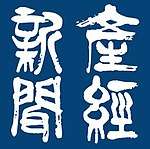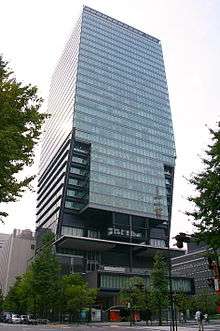Sankei Shimbun
 | |
| Type | Daily newspaper |
|---|---|
| Format | Broadsheet (54.6 cm × 40.65 cm) |
| Owner(s) | Sankei Shimbun Co., Ltd. |
| Publisher | Takamitsu Kumasaka |
| Founded | March 1, 1882 (as jiji news); June 20, 1933 (as nihon kogyo shimbun) |
| Political alignment | Conservative[1] |
| Language | Japanese |
| Headquarters | Tokyo & Osaka & Fukuoka |
| Circulation |
Morning edition: 2,191,587 Evening edition:[2] 635,988 (ABC Japan, October 2005) |
| Website |
産経ニュース(sankei news): News Site 産経新聞社: Corporate Site |
Sankei Shimbun (産経新聞 Sankei Shinbun, literally "Industrial and Economic Newspaper") is a daily newspaper in Japan published by the Sankei Shimbun Co., Ltd. (株式会社産業経済新聞社 Kabushiki-gaisha Sangyō Keizai Shinbunsha).The Sankei is abbreviation name of Sangyō Keizai. It has the sixth highest circulation for a newspapers in Japan, and is considered one of the five leading "national" newspapers.[3]
Corporate profile


The Sankei Shimbun is part of the Fujisankei Communications Group and is 40% owned by Fuji Media Holdings. The company is also the owner of Osaka Broadcasting Corporation (OBC, Radio Osaka).
History
Source:[4]
The history of the Sankei Shimbun began with the founding of two old newspapers: Jiji News and Nihon Kogyō Shimbun.
Jiji News was founded first in 1882 by Fukuzawa Yukichi who was a Japanese author, translator, journalist and founder of Keio University.
Nihon Kogyō Shimbun was founded second in 1933 by Hisakichi Maeda. The newspaper specialized in industrial, business, and economic affairs, and was published by The Minami-OSAKA Shimbun (Evening newspaper South OSAKA).
In 1941, Osaka Shimbun (renamed from Minami-Osaka Shimbun) merged the Osaka Jiji shimpō (Jiji-shimpō Osaka edition). The following year, Nihon Kogyō Shimbun merged the other newspapers in business and industrial affairs in Western Japan, and changed its name to the Sangyō Keizai Shimbun (or the Sankei).
In 1952, the Sankei hired a female writer (editor) for the first time in the newspapers in Japan. In 1955, The Sankei merged Jiji shimpō.
In 1958, the Sankei was acquired by Shigeo Mizuno and Nobutaka Shikanai, the two men who founded Fuji Television the year before.[5] The Sankei changed direction from Liberalism for Conservatism (Tenkō).
In 1959, the Sankei and Jiji shimpō were placed under a Sankei Shimbun masthead.
The Sankei Shimbun started two online newspapers in 1996: Sankei Web, with website style, and E-NEWS, with personal digital assistant style. In 2001, the Sankei Shimbun started a new electronic newspaper delivery edition, NEWSVUE.
In 2002, the Sankei Shimbun merged Osaka Shimbun. Both editions were placed under the Sankei Shimbun masthead.
In 2005, the Sankei Shimbun renewed its digital edition with movie, suitable for smartphone, and renamed Sankei NetView. In 2007, the Sankei Shimbun started a new online newspaper, MSN Sankei news, in collaboration with Microsoft.
In 2014, the Sankei Shimbun rebranded its online news as Sankei News.
Ownership
- Sankei Shimbun (産経新聞 Sankei Shimbun), a leading conservative opinion newspaper.
- FujiSankei Business i (フジサンケイビジネスアイ FujiSankei Business i), a industry & business & economy newspaper that renamed Nihon Kogyo Shimbun (Japan Industry Newspaper) in March 2004.
- Sankei Sports (サンケイスポーツ, Sankei Sports), a leading Japanese daily sports newspaper since 1955.
- Yukan Fuji (夕刊フジ, Fuji Evening Edition), a leading Japanese daily evening newspaper since 1969.
- Keiba Eight (競馬エイト, Keiba Eight), a leading horse racing newspaper since 1971.
- Osaka Shimbun (大阪新聞), a Kansai regional evening newspaper (Suspension of publication since 2002).
- Sankei Express (サンケイエクスプレス(産経エクスプレス),SANKEI EXPRESS Sankei Express), a targeted at young people newspaper founded in 2006.
Political stance
The Sankei Shimbun is Reactionary and Right-wing politics newspaper.[6]
Sankei Award, Sankei Prize
- Praemium Imperiale - This (Japanese: 高松宮殿下記念世界文化賞, Takamatsu no miya denka kinen sekai bunka-shō),(lit. "World Culture Prize in Memory of His Imperial Highness Prince Takamatsu") International art prize awarded since 1989 by the imperial family of Japan on behalf of the Japan Art Association in the fields of painting, sculpture, architecture, music, and theatre/film.
- Tokyo Police Officers Prize (Japanese: 都民の警察官, Tomin no Keisatsukan) - Major Award in Japan, since 1952.
- Peoples' Self-Defense Officials Prize(Japanese: 国民の自衛官, Kokumin no Jieikan) - Self-Defense Officials Commendation Award in Japan, since 2002.
- Sankei Children's Book Award (Japanese: 産経児童出版文化賞, Sankei jidou shuppan bunka Shō) - Major and the oldest Children's literature Award in Japan.
- Naniwa Art Festival (Japanese: なにわ藝術祭, Naniwa Geijutu Sai) - Major traditional culture Award (Rakugo(Japanese verbal entertainment, Comic story), Buyō(Japanese dance), Modern dance, Classical music, Jazz) in Japan, since 1964. (Naniwa means the place that became the modern Japanese city of Osaka)
- Sankei International Calligraphic Art Exhibition (Japanese: 産経国際書展, Sankei Kokusai Sho-Ten) - Major Kanji(Japanese calligraphy) Award in Japan, since 1984.
Philanthropy
- Akemi Chan Fund - (Japanese: 明美ちゃん基金, Akemi Chan Kikin) is a Japan-based Medical Fund for the poor children suffering heart troubles.(in Japanese)
- Sankei shimbun social welfare association - (Japanese: 産経新聞厚生文化事業団, Sankei Kousei bunka jigyodan) is a nonprofit organization in Japan. (in Japanese)
Offices
- Tokyo Head Office (registered headquarters): Tokyo Sankei Building, 1(= Itchome)-7-2, Otemachi, Chiyoda, Tokyo
- Osaka Head Office: Namba Sankei Building, 2(= Nichome)-1-57, Minatomachi, Naniwa-ku, Osaka
- Western Office (Fukuoka): Sunlight Building, 5-23-8, Watanabe-dori, Chuo-ku, Fukuoka
Sankei Group affiliate companies
- Fujisankei Communications Group
- Fuji Television - Fuji Television Network, Inc. (株式会社フジテレビジョン Kabushiki Gaisha Fuji Terebijon) is a Major Japanese television station, also known as Fuji TV (フジテレビ Fuji Terebi) or CX. It is the flagship station of the Fuji News Network (FNN) and the Fuji Network System.
- Kansai Telecasting Corporation
- Osaka Broadcasting Corporation - Osaka Broadcasting Corporation (大阪放送株式会社 Osaka Hoso Kabushiki-gaisha, OBC) is a leading AM radio station of National Radio Network (NRN) in Osaka, Japan, and it is known as "Radio Osaka (ラジオ大阪 Rajio Osaka)".
- FM 802 - FM802 (エフエムはちまるに Efu Emu Hachi Maru Ni) is a leading FM radio station in Kansai,Japan.
- FM COCOLO - FM Cocolo (エフエムココロ Efu Emu Kokoro) is a multilingual FM radio station owned and operated by FM 802 Co., Ltd
- Iwate Menkoi Television - Iwate area
- Sendai Television - Miyagi area
- Fukushima Television Broadcasting - Fukushima area
- Niigata Sogo Television - Niigata area
- Nagano Broadcasting Systems - Nagano area television station
- TV Shizuoka - Shizuoka area television station
- Okayama Broadcasting - Okayama area television station
- Ehime Broadcasting - Ehime area television station
- Shinhiroshima Telecasting - Hiroshima area television station
- Kochi Sun Sun Broadcasting - Kochi area television station
- Tokyo Tower - Hisakichi Maeda (前田 久吉) was the tower's founder and owner.
- FM Osaka - The owner is Hisakichi Maeda's family.
- Japan Airlines - Descendants of Sankei Shimbun Aviation Department 産経新聞航空部 (Sankei Shimbun koukubu)
Notable corporate alumni
- Yoshirō Mori, the President of Tokyo Organising Committee of the Olympic and Paralympic Games. the 85th and 86th Prime Minister of Japan.
- Fukushiro Nukaga, former Minister of Finance of Japan
- Eriko Yamatani, politician.former Chairman of the National Public Safety Commission (Japan), former Minister for the Abduction Issue
- Tsuneo Kitamura, politician.House of Councillors (Japan)
- Kenta Matsunami, politician.House of Representatives (Japan)
- Hiroshi Nakatsuka, Japanese politician.former mayor of Hirakara city.
- Shoko Yamaguchi, Legion of Honour in 2013.
- Ryōtarō Shiba, author
- Sakunosuke Oda, author
- Ikko Tanaka, graphic designer worked at 1964 Summer Olympics, Expo '70, Expo '85, Expo '90
- Masami Abe, scooped the in 1980
- Tsutomu Saitō, Chief operating officer at Sankei. He scooped the Dissolution of the Soviet Union in 1990
- Katsuhiro Kuroda, columnist at Sankei, in Seoul Branch (South Korea)
- Yoshihisa Komori, columnist at Sankei, in Washington, D.C. Branch (United States)
- Tatsuya Kato (journalist), columnist at Sankei
- Ayari Aoyama, writer at sankei. She is butterfly swimmer, at the 1996 Summer Olympics
- Monta Mino, radio and television announcer
Controversy
In August 2014, South Korea filed suit against Sankei for insults against Park Geun-hye, the president of South Korea, and demanded Tatsuya Kato, head of the Seoul Bureau, present himself for questioning.[7][8][9][10][11] The article was about several rumors about Park during the Sinking of the MV Sewol, referring to Korean news reports. Sankei referred to Chosun Ilbo; however, only Sankei was charged with defamation. Sankei was considered an anti-Korean newspaper in Korea.[12] Thus, Japanese media assumed the suit was a warning to Sankei.[13][14]
In December 2014, the newspaper apologized after running Richard Koshimizu's ad promoting anti-Semitic books.[15][16]
On February 11, 2015, regular columnist Ayako Sono wrote an opinion piece suggesting that while it will be necessary for Japan to accept more immigrants in order to bolster a decreasing workforce, Japan should take steps to ensure the separation of immigrants in regards to living conditions, citing South African apartheid as an example of how to achieve this goal.[17][18][19]
See also
- Anti-Korean sentiment in Japan
- Anti-Chinese sentiment in Japan
- Praemium Imperiale
- Fujisankei Communications Group
- Tokyo Marathon
- Osaka International Ladies Marathon
- Japanese media
- Liberal Democratic Party (Japan) (LDP)
- Shinzō Abe, Prime Minister of Japan and the President of the LDP
- Kakuei Tanaka, Former PM of Japan and President of LDP
References
- ↑ Reuters in 2018 refers to Sankei as a conservative newspaper. https://www.reuters.com/article/us-japan-immigration/demand-for-foreign-workers-may-soften-japans-immigration-rules-idUSKBN1JB05H
- ↑ Evening edition is published only for Kansai region.
- ↑ Pharr, Susan J.; Ellis S. Krauss (1996). Media and politics in Japan. University of Hawaii Press. p. 4. ISBN 0-8248-1761-3.
- ↑ "History : COMPANY". sankei.jp. Archived from the original on 2014-07-31. Retrieved 29 Jan 2017.
- ↑ http://kigyoka.com/news/magazine/magazine_20130508.html
- ↑ "Editorship". sankei.jp. Archived from the original on 2016-10-13. Retrieved 29 Jan 2017.
- ↑ http://www.koreaherald.com/view.phpōud=20140810000273%5Bpermanent+dead+link%5D
- ↑ http://english.donga.com/srv/service.php3ōbiid=2014081155588%5Bpermanent+dead+link%5D
- ↑ "Sankei Seoul bureau chief grilled over Park article". 18 August 2014 – via Japan Times Online.
- ↑ "Archived copy". Archived from the original on 2014-08-19. Retrieved 2014-08-18.
- ↑ Gale, Alastair (10 October 2014). "Korean Prosecutors Indict Japanese Journalist on Defamation Charge" – via online.wsj.com.
- ↑ "Sankei Shimbun's defamation of Korea goes too far". Dong-a Ilbo. South Korea. 2014-08-11. Retrieved 2014-10-27.
- ↑ "EDITORIAL: South Korea's suppression of press freedom undermines democracy". Asahi Shimbun. Japan. 2014-09-03. Archived from the original on 2014-10-27. Retrieved 2014-10-27.
- ↑ "Seoul court acquits Japanese reporter of defaming president".
- ↑ Obe, Mitsuru (6 December 2014). "Japan Newspaper Apologizes Over Advertisement for 'Jewish Conspiracy' Books".
- ↑ "Page not found". The Japan Times.
- ↑ Johnston, Eric; Osaki, Tomohiro (12 February 2015). "Author Sono calls for racial segregation in op-ed piece" – via Japan Times Online.
- ↑ Hayashi, Yuka (13 February 2015). "Author Causes Row With Remarks on Immigration, Segregation".
- ↑ Lies, Elaine. "Japan PM ex-adviser praises apartheid in embarrassment for Abe".
External links
- 産経電子版 (in Japanese), Sankei denshi ban (Electronic newspaper delivery edition (Digital edition)) renewed in 2016.
- 産経ニュース (in Japanese), Sankei News, website since 2014.
- MSN産経ニュース (in Japanese), MSN Sankei News, website in MSN Japan since 2007 till 2014.
- 産経ニュースWEST ( 産経関西 Sankei Kansai) (in Japanese), Sankei news's Kansai & WesternJapan edition.
- JAPAN Forward, an English-language news & opinion website created by the Sankei Shimbun.
- Special Report about North Korean abduction (JAPAN Forward)
- Tokyo Marathon official website
- Osaka International Ladies Marathon official website
- Naniwa Art Festival(in Japanese)
- Sankei International Calligraphic Art Exhibition(in Japanese)